Burning Trash for Science: The Potential Use of Discarded Waste to Monitor Energy Fluxes Delivered to Ecosystem Components by Wildfires
Abstract
1. Introduction
2. Materials and Methods
2.1. Trash Type
2.2. Laboratory Experiments
2.3. Field Experiments
3. Results
3.1. Plastic Bottles
3.2. Aluminium Cans
4. Discussion
5. Conclusions
Author Contributions
Funding
Data Availability Statement
Acknowledgments
Conflicts of Interest
References
- Keeley, J.E. Fire intensity, fire severity and burn severity: A brief review and suggested usage. Int. J. Wildland Fire 2009, 18, 116–126. [Google Scholar] [CrossRef]
- Byram, G.M. Combustion of Forest Fuels. In Forest Fire: Control and Use; Davis, K.P., Ed.; McGraw-Hill: New York, NY, USA, 1959; pp. 61–89. [Google Scholar]
- Andrews, P.L.; Heinsch, F.A.; Schelvan, L. How to Generate and Interpret Fire Characteristics Charts for Surface and Crown Fire Behavior; General Technical Report RMRSGTR-253; Department of Agriculture, Forest Service, Rocky Mountain Research Station: Fort Collins, CO, USA, 2011; p. 40.
- Silvani, X.; Morandini, F.; Muzy, J.-F. Wildfire spread experiments: Fluctuations in thermal measurements. Int. Commun. Heat Mass Transf. 2009, 36, 887–892. [Google Scholar] [CrossRef]
- Mueller, E.V.; Skowronski, N.; Thomas, J.C.; Clark, K.; Gallagher, M.R.; Hadden, R.; Mell, W.; Simeoni, A. Local measurements of wildland fire dynamics in a field-scale experiment. Combust. Flame 2018, 194, 452–463. [Google Scholar] [CrossRef]
- Belcher, C.M.; New, S.L.; Gallagher, M.R.; Grosvenor, M.J.; Clark, K.; Skowronski, N.S. Bark charcoal reflectance may have the potential to estimate the heat delivered to tree boles by wildland fires. Int. J. Wildland Fire 2021, 30, 391–397. [Google Scholar] [CrossRef]
- Bova, A.S.; Dickinson, M.B. Beyond “fire temperatures”: Calibrating thermocouple probes and modeling their response to surface fires in hardwood fuels. Can. J. For. Res. 2008, 38, 1008–1020. [Google Scholar] [CrossRef]
- Loudermilk, E.L.; O’Brien, J.J.; Mitchell, R.J.; Cropper, W.P.; Hiers, J.K.; Grunwald, S.; Grego, J.; Fernandez-Diaz, J.C. Linking complex forest fuel structure and fire behaviour at fine scales. Int. J. Wildland Fire 2012, 21, 882–893. [Google Scholar] [CrossRef]
- Parson, A.; Robichaud, P.R.; Lewis, S.A.; Napper, C.; Clark, J.T. Field Guide for Mapping Post-Fire Soil Burn Severity; General Technical Report RMRS-GTR-243; Department of Agriculture, Forest Service, Rocky Mountain Research Station: Fort Collins, CO, USA, 2010; p. 49.
- New, S.L.; Hudspith, V.A.; Belcher, C.M. Quantitative charcoal reflectance measurements better link to regrowth potential than ground-based fire-severity assessments following a recent heathland wildfire at Carn Brea, Cornwall, UK. Int. J. Wildland Fire 2018, 27, 845–850. [Google Scholar] [CrossRef]
- Viana-Soto, A.; Aguado, I.; Martinez, S. Assessment of Post-Fire Vegetation Recovery Using Fire Severity and Geographical Data in the Mediterranean Region (Spain). Environments 2017, 4, 90. [Google Scholar] [CrossRef]
- Joao, T.; Joao, G.; Bruno, M.; Joao, H. Indicator-based assessment of post-fire recovery dynamics using satellite NDVI time-series. Ecol. Indic. 2018, 89, 199–212. [Google Scholar] [CrossRef]
- Hood, S.M.; Cluck, D.R.; Smith, S.L.; Ryan, K.C. Using bark char codes to predict post-fire cambium mortality. Fire Ecol. 2008, 4, 57–73. [Google Scholar] [CrossRef]
- Morgan, P.; Keane, R.E.; Dillon, G.K.; Jain, T.B.; Hudak, A.T.; Karau, E.C.; Pikkink, P.G.; Holden, Z.A.; Strand, A.K. Challenges of assessing fire and burn severity using field measures, remote sensing and modelling. Int. J. Wildland Fire 2014, 23, 1045–1060. [Google Scholar] [CrossRef]
- Hood, S.M.; Lutes, D. Predicting post-firetree mortality for 12 Western US conifers using the First Order Fire Effects Model (FOFEM). Fire Ecol. 2017, 13, 66–84. [Google Scholar] [CrossRef]
- Beschta, R.L.; Rhodes, J.J.; Kauffman, J.B.; Gresswell, R.E.; Minshall, G.W.; Karr, J.R.; Perry, D.A.; Hauer, F.R.; Frissell, C. Postfire management on forested public lands of the western United States. Conserv. Biol. 2004, 18, 957–967. [Google Scholar] [CrossRef]
- Kuenzi, A.M.; Fule, P.Z.; Sieg, C.H. Effects of fire severity and pre-fire stand treatment on plant community recovery after a large wildfire. For. Ecol. Manag. 2008, 255, 855–865. [Google Scholar] [CrossRef]
- Brooks, M.L. Peak fire temperatures and effects on annual plants in the Mojave Desert. Ecol. Appl. 2002, 12, 1088–1102. [Google Scholar] [CrossRef]
- Keeley, J.E.; Fotheringham, C.J.; Baer-Keeley, M. Determinants of post-fire recovery and succession in Mediterranean-climate shrublands of California. Ecol. Appl. 2005, 15, 1515–1534. [Google Scholar] [CrossRef]
- Simard, A.J. Fire severity, changing scales, and how things hang together. Int. J. Wildland Fire 1991, 1, 23–34. [Google Scholar] [CrossRef]
- Rosero-Vlasova, O.A.; Perez-Cabello, F.; Lloveria, R.M.; Vlassova, L. Assessment of laboratory VIS-NIR-SWIR setups with different spectroscopy accessories for characterisation of soils from wildfire burns. Biosyst. Eng. 2016, 152, 51–67. [Google Scholar]
- Belcher, C.M.; New, S.L.; Santin, C.; Doerr, S.H.; Dewhirst, R.; Grosvenor, M.J.; Hudspith, V.A. What can charcoal reflectance tell us about energy release in wildfires and the properties of pyrogenic carbon. Front. Earth Sci. 2018, 6, 169. [Google Scholar] [CrossRef]
- Wotton, B.M.; Gould, J.S.; McCaw, W.L.; Cheney, N.P.; Taylor, S.W. Flame temperature and residence time of fires in dry eucalypt forest. Int. J. Wildland Fire 2012, 21, 270–281. [Google Scholar] [CrossRef]

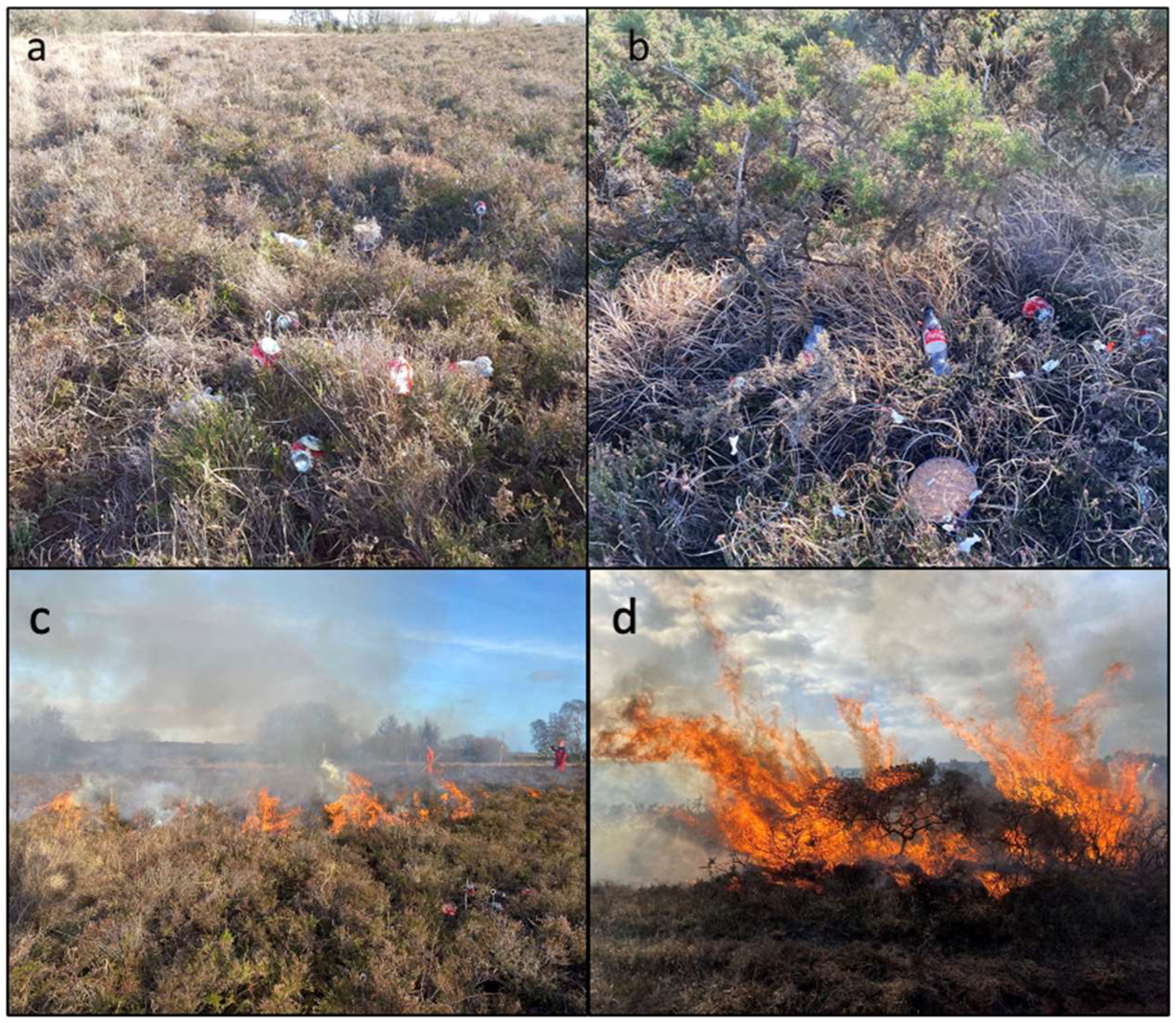
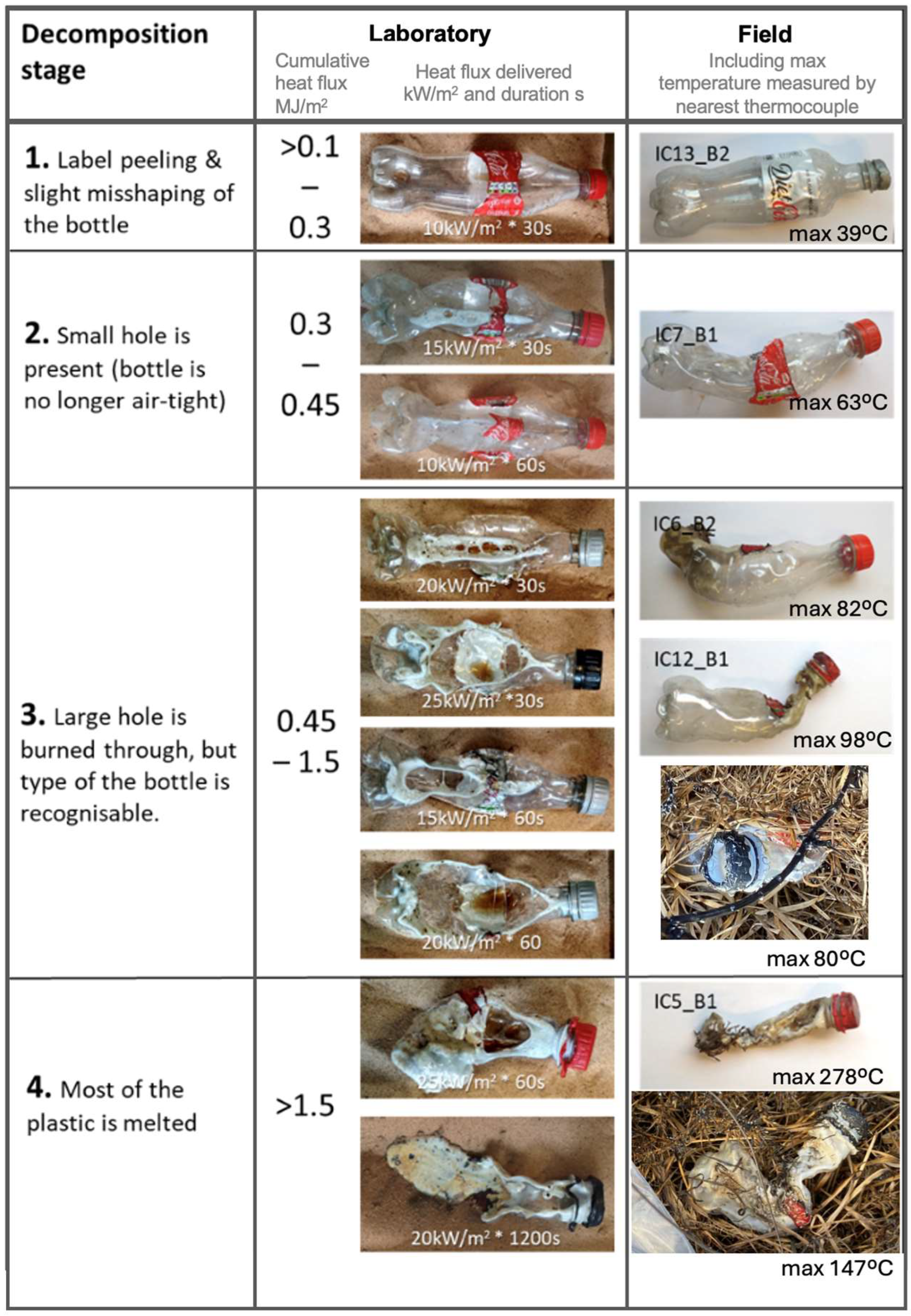
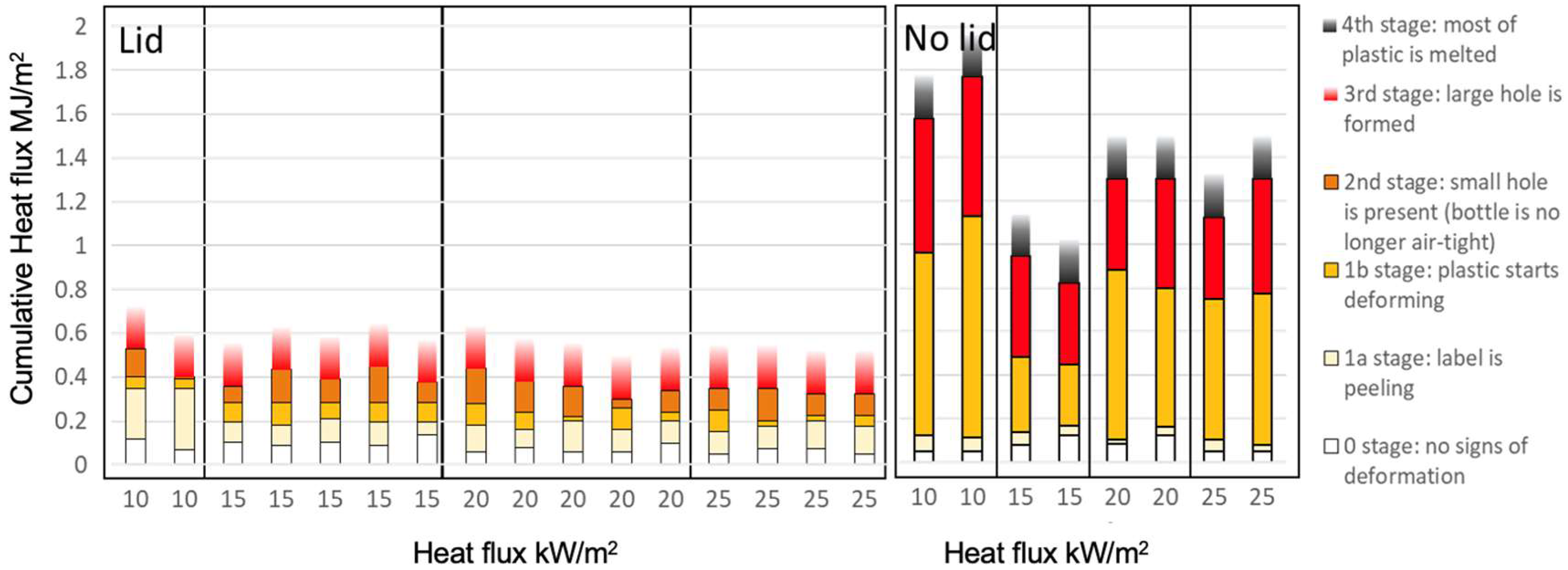
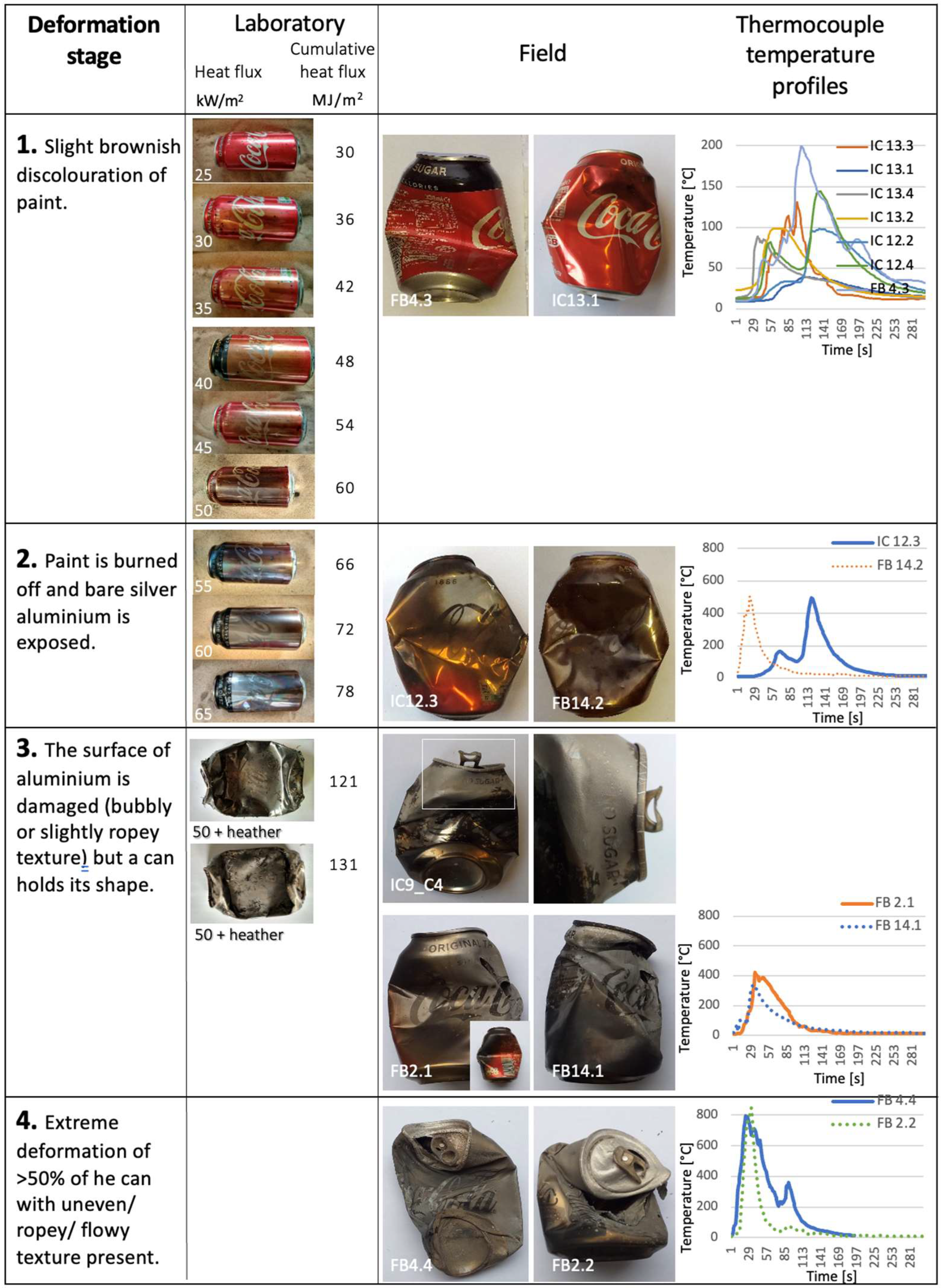
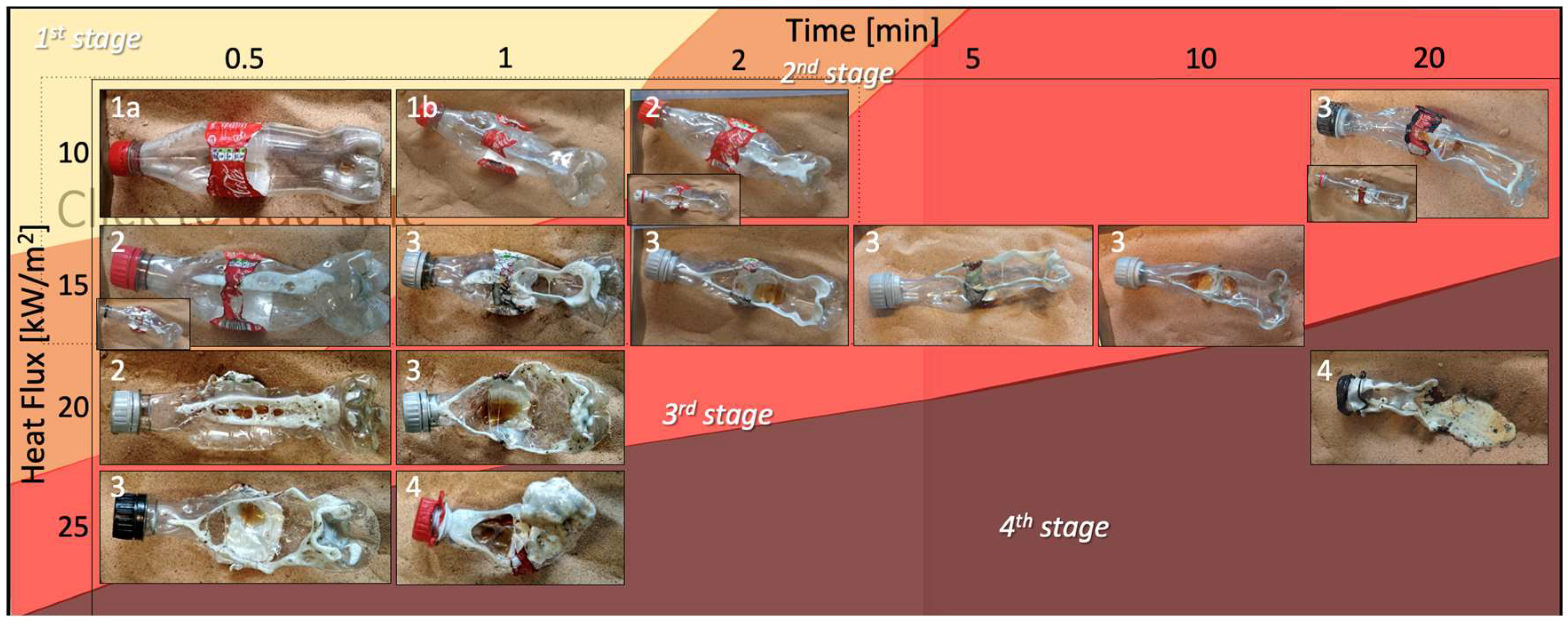
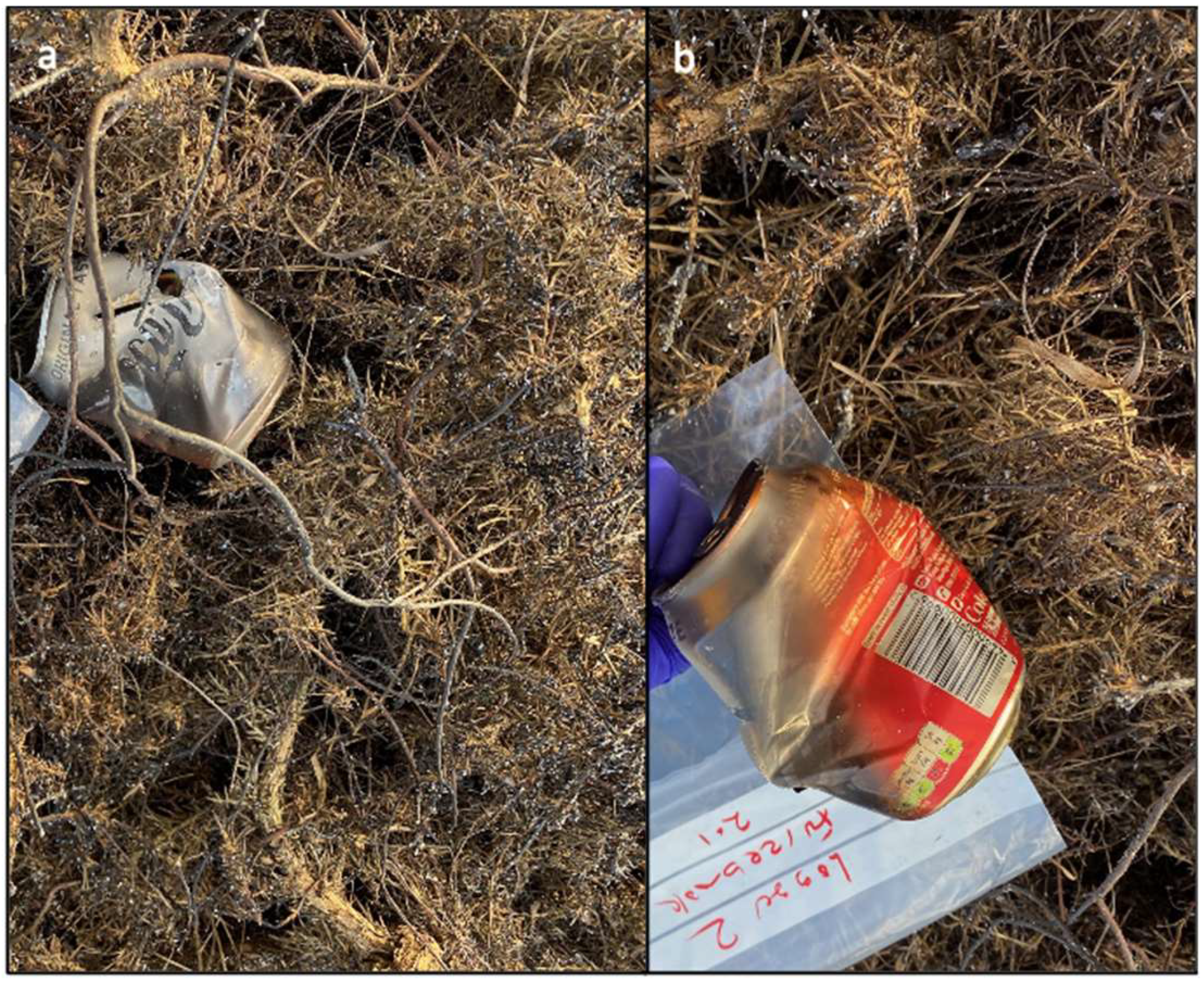

| Cone Heater Set Temperature, °C | Measured Heat Flux at Item Surface, kW/m2 | Temperature at the Surface of the Item, °C |
|---|---|---|
| 413 | 10 | 75 |
| 482 | 15 | 110 |
| 547 | 20 | 135 |
| 600 | 25 | 165 |
| 645 | 30 | 180 |
| 681 | 35 | 205 |
| 715 | 40 | 225 |
| 750 | 45 | 260 |
| 778 | 50 | 285 |
| 806 | 55 | 301 |
| 830 | 60 | 323 |
| 855 | 65 | 358 |
| Sample | Heat Flux [kW/m−2] | Total Heating Time [s] | Lid Present or Absent | Time at which Label Started Peeling [s] | Time at which Plastic Starts Deforming [s] | Time to Lid Popping (Where Present 0 [s]) | Time to Melting a Hole [s] | Time to Plastic Clouding [s] |
|---|---|---|---|---|---|---|---|---|
| 2 | 10 | 120 | Y | 12 | 35 | 40 | 40 | 53 |
| 5 | 10 | 120 | N | 5 | 7 | No Lid | 84 | 62 |
| 7 | 15 | 30 | Y | 7 | 13 | 19 | 19 | 24 |
| 13 | 15 | 30 | N | 8 | 3 | No Lid | No Hole | 25 |
| 9 | 15 | 120 | Y | 7 | 14 | 19 | 19 | 26 |
| 12 | 15 | 120 | N | 5 | 4 | No Lid | 23 | 31 |
| 17 | 20 | 60 | Y | 3 | 10 | 11 | 11 | 18 |
| 20 | 20 | 60 | Y | 4 | 1 | 16 | 16 | 19 |
| 21 | 20 | 60 | N | 4 | 1 | No Lid | 39 | 21 |
| 22 | 20 | 60 | N | 6 | 2 | No Lid | 32 | 25 |
| 24 | 25 | 30 | Y | 3 | 7 | 8 | 8 | 14 |
| 27 | 25 | 30 | N | 2 | 2 | No Lid | 26 | 15 |
| 28 | 25 | 30 | N | 2 | 1 | No Lid | 28 | 21 |
| Location | Themo-Couple Number | Decomposition Stage | Max Temp. | >40 °C | >140 °C (Plastic Softening) | >260 °C (Plastic Melting) | >660 °C (Aluminium Melting) | ||||||
|---|---|---|---|---|---|---|---|---|---|---|---|---|---|
| In Can | Out Can | Near Bottle | Duration | Area Under Curve | Duration | Area Under Curve | Duration | Area Under Curve | Duration | Area Under Curve | |||
| Location of Thermocouple | [°C] | [s] | [s × °C] | [s] | [s × °C] | [s] | [s × °C] | [s] | [s × °C] | ||||
| Aluminium Cans | |||||||||||||
| IC | 13.4 | 1 | 89 | 208 | 5023 | 0 | 0 | 0 | 0 | 0 | 0 | ||
| IC | 12.2 | 1 | 98 | 274 | 9631 | 0 | 0 | 0 | 0 | 0 | 0 | ||
| IC | 13.2 | 1 | 99 | 252 | 7598 | 0 | 0 | 0 | 0 | 0 | 0 | ||
| IC | 13.3 | 1 | 131 | 114 | 6808 | 0 | 0 | 0 | 0 | 0 | 0 | ||
| IC | 12.4 | 1 | 144 | 276 | 13,755 | 10 | 1430 | 0 | 0 | 0 | 0 | ||
| FB | 4.3 | 1 | 200 | 641 | 19,651 | 38 | 6593 | 0 | 0 | 0 | 0 | ||
| IC | 12.3 | 2 | 498 | 204 | 26,172 | 67 | 18,075 | 30 | 11,473 | 0 | 0 | ||
| FB | 14.2 | 2 | 506 | 179 | 15,918 | 40 | 12,343 | 24 | 9290 | 0 | 0 | ||
| FB | 14.1 | 3 | 335 | 207 | 17,133 | 44 | 10,306 | 16 | 4908 | 0 | 0 | ||
| FB | 2.1 | 3 | 423 | 212 | 21,487 | 66 | 18,738 | 38 | 13,226 | 0 | 0 | ||
| FB | 4.4 | 4 | 793 | 280 | 54,091 | 123 | 47,370 | 79 | 38,434 | 21 | 15,205 | ||
| FB | 2.2 | 4 | 844 | 252 | 21,959 | 36 | 17,772 | 27 | 16,006 | 12 | 9257 | ||
| Plastic Bottles | |||||||||||||
| FB | 14.4 | 2 | 59 | 66 | 1365 | 0 | 0 | 0 | 0 | 0 | 0 | ||
| FB | 14.3 | 2 | 80 | 147 | 3653 | 0 | 0 | 0 | 0 | 0 | 0 | ||
| FB | 2.4 | 3 | 147 | 159 | 8521 | 10 | 1438 | 0 | 0 | 0 | 0 | ||
| FB | 4.1 | 4 | 495 | 336 | 28,719 | 61 | 17,386 | 31 | 11,943 | 0 | 0 | ||
| FB | 4.2 | 4 | 618 | 681 | 163,614 | 401 | 15,009 | 369 | 14,403 | 0 | 0 | ||
Disclaimer/Publisher’s Note: The statements, opinions and data contained in all publications are solely those of the individual author(s) and contributor(s) and not of MDPI and/or the editor(s). MDPI and/or the editor(s) disclaim responsibility for any injury to people or property resulting from any ideas, methods, instructions or products referred to in the content. |
© 2025 by the authors. Licensee MDPI, Basel, Switzerland. This article is an open access article distributed under the terms and conditions of the Creative Commons Attribution (CC BY) license (https://creativecommons.org/licenses/by/4.0/).
Share and Cite
Losiak, A.; Avery, A.; Elliott, A.; Baker, S.J.; Belcher, C.M. Burning Trash for Science: The Potential Use of Discarded Waste to Monitor Energy Fluxes Delivered to Ecosystem Components by Wildfires. Fire 2025, 8, 373. https://doi.org/10.3390/fire8090373
Losiak A, Avery A, Elliott A, Baker SJ, Belcher CM. Burning Trash for Science: The Potential Use of Discarded Waste to Monitor Energy Fluxes Delivered to Ecosystem Components by Wildfires. Fire. 2025; 8(9):373. https://doi.org/10.3390/fire8090373
Chicago/Turabian StyleLosiak, Ania, Amber Avery, Andy Elliott, Sarah J. Baker, and Claire M. Belcher. 2025. "Burning Trash for Science: The Potential Use of Discarded Waste to Monitor Energy Fluxes Delivered to Ecosystem Components by Wildfires" Fire 8, no. 9: 373. https://doi.org/10.3390/fire8090373
APA StyleLosiak, A., Avery, A., Elliott, A., Baker, S. J., & Belcher, C. M. (2025). Burning Trash for Science: The Potential Use of Discarded Waste to Monitor Energy Fluxes Delivered to Ecosystem Components by Wildfires. Fire, 8(9), 373. https://doi.org/10.3390/fire8090373







